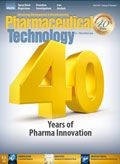Evolution of Dosage-Form Development and Manufacturing Strategies
Anil Kane, executive director, Global Head of Technical & Scientific Affairs at Patheon, shared his perspective of changes to solid-dosage pharmaceutical manufacturing.
Anil Kane, executive director, Global Head of Technical & Scientific Affairs at Patheon, shared his perspective of changes to solid-dosage pharmaceutical manufacturing.
PharmTech: What have been the most significant changes in solid-dosage manufacturing in the past 40 years and in the past five or 10 years?
Kane (Patheon): A shrinking new drug-discovery pipeline has led to significant changes in dosage form development and manufacturing strategies, infrastructure requirements, and methodologies. Examples include evaluating existing molecules for newer indications in the same or different therapeutic categories and combining new drug entities with off-patent drug candidates for synergistic effects or other clinical benefits of fixed-dose combinations. Applying a much higher level of process understanding and robustness justification, as required by regulatory authorities, using principles of quality by design (QbD) and a systematic approach, have led to the evolution of fully-instrumented equipment with data capture, sensor feedback loops, and possible real-time release opportunities. Other changes have been increasing automation, documentation control, and training to bring in a culture of quality.
Safe handling of many of the new drugs that are high potent requires fully contained equipment, processes, and systems to safeguard the health of operators. Facilities and environmental controls are now required to be designed around plant personnel safety. Automated, closed-loop product transfers between processes, isolators, and equipment with clean-in-place (CIP) or wash-in-place (WIP) capabilities enable production.
With an aging population, there is a need to have products suitable for geriatric patients. Combination therapies, reducing pill burden, and minimizing the challenge of polypharmacy enhances patient compliance. The need for better and palatable drug products for the pediatric population also requires changes in strategy to manufacture patient-friendly dosage forms for better compliance. Pediatric formats (e.g., sprinkles, mini-tablets, and dispersible tablets), controlled-release dosage forms, and fixed-dose combinations (e.g., multi-layer tablets or multi-particulates in capsules) have driven the need for equipment to support manufacture of these novel dosage forms.
We have also seen early-stage investment and adoption of continuous manufacturing. Drivers include reduced API requirements for clinical and commercial launch, better process understanding and control, and a significant lower cost of commercial goods.
Quality, compliance, and data integrity requirements in the pharmaceutical industry have led to increased automation and documentation control with minimum operator interface. Regulatory submissions now require a much deeper understanding of the process and development of pharmaceutics that justify a robust quality product. Evolution of systems and procedures in drug substance and drug product manufacturing, using a systematic approach of understanding the molecule, utilizing risk assessment, and scaling up the process by first principles and having a mechanistic understanding helps to meet this requirement.
PharmTech: What trends or developments do you foresee for the near future?
Kane (Patheon): The industry will slowly embrace the long-term benefits of continuous manufacturing and will invest in this model to develop clinical and commercial products. Multiple-drug combinations will continue; we have seen two to four drug candidates being combined into a single dosage form, which is convenient to patients and will hopefully improve compliance.
Combining diagnostic devices and drugs (from a technology standpoint and having a clear regulatory approval pathway) will bring several benefits to patients. In addition, drugs have been targeted to specific sites of activity or absorption to enhance the therapeutic effect. Use of biodegradable sensors, imaging techniques, and application of medical/pharmaceutical electronics will help deliver drugs accurately and at a predetermined rate for enhanced efficacy. Ingestible sensors could potentially monitor the compliance of drug administration and also monitor drug misuse. Technological advances such as these can help personalize therapy and delivery of the right drug(s) for improving therapy.
Article DetailsPharmaceutical Technology
Vol. 41, No. 7
Pages: 40
Citation:
When referring to this article, please cite it as J. Markarian, “Evolution of Dosage-Form Development and Manufacturing Strategies," Pharmaceutical Technology 41 (7) 2017.

Drug Solutions Podcast: A Closer Look at mRNA in Oncology and Vaccines
April 30th 2024In this episode fo the Drug Solutions Podcast, etherna’s vice-president of Technology and Innovation, Stefaan De Koker, discusses the merits and challenges of using mRNA as the foundation for therapeutics in oncology as well as for vaccines.
Pharmaceutical Tariffs Are Imminent: How Industry is Bracing for Impact
April 16th 2025On April 14, 2025, the Trump Administration launched a national security-driven investigation into pharmaceuticals, a move that will likely result in tariffs being placed on pharmaceutical drugs, ingredients, and other components that are imported from outside of the United States.
